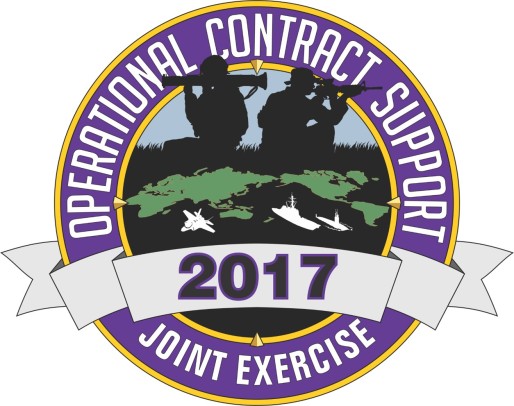By Senior Master Sgt. Andrew Leonhard
OCSJX-17 Public Affairs Cell
FORT BLISS, Texas – Nearly 450 Sailors, Airmen, Soldiers, Marines and civilians are here for Operational Contract Support Joint Exercise-17 and a significant number of them are from the Army’s Mission and Installation Contracting Command.
Approximately 50 MICC personnel are participating in the exercise or providing support to ensure the exercise is successful. Most of the MICC participants will deploy within the next six months, including some who are only days away from heading downrange as contracting professionals for the first time. Other MICC Soldiers helped synchronize the assessment part of the exercise including the nearly 270 scenario injects that flowed into the week-long exercise portion of the joint exercise.
U.S. Army Capt. Richard Smith is the Trainer/Observer Integrator and he is a vital link between the assessment cell and what the participants are learning or discovering from each inject. This is his second OCSJX; in 2016 he was a trainee.
“I synchronize the information that each of the 15 TOs are witnessing in the training cells and make sure it’s ready for the assessment team to be able to see not only how well the training audience is responding to an scenario, but also where any short falls may be,” said Smith who is assigned to the 676th Contracting Team, 902nd Contracting Battalion, Joint Base Lewis-McCord, Washington. “Because we’re not only trying to help each of the individual trainees with their own personal experiences and growth, but we’re also looking across the Army and the Air Force to see where our gaps in capabilities are and how we can possibly tailor this to improve the trainees experience next year.”
Just across the hall from Smith was one of those trainees, U.S. Army Staff Sgt. Stephanie Cortez, a member of this year’s Regional Contracting Element-Hotel. She was not only going through her initial OCS exercise, but she is just a few weeks from deploying as a contracting specialist for the first time. She stated, that like all Soldiers, she is adaptive and was ready to deploy and would have made it work, but now she is definitely set up for success.
“Learning the programs tools and getting hands on, really helps,” she explained. “I also have been looking over-the-shoulder of more experienced team members and watching how they do things and have asked questions. I’m very excited about using what I’ve learned.”
Cortez is stationed at the MICC-Fort Bliss contracting office and stated that on a previous deployment she performed convoy escort duties. During that deployment, she was moving a lot of the equipment and supplies to the units that needed them. On her return trip to Southwest Asia, she will be a contracting specialist who plans, procures and manages the acquisition of equipment and supplies.
“Now I really know that it’s more than just someone handing me a requirement saying we need this,” she said. “Now it’s understanding that there is a bigger picture to why the warfighter needs that request filled.”
Lt. Col. Jarrett Moffitt, the commander of the 919th Contracting Battalion, concurred with Cortez’s statement, saying that the opportunity for participants to learn more about the effects on the battle field is a big take away from the exercise.
“This is a great opportunity for our young Soldiers to learn about operationalizing contracting and getting into the nuts and bolts of contract writing to ensure we’re providing the effects the customer (warfighter) needs on the battlefield,” stated Moffitt who had the role of chief of the Regional Contracting Element-Alpha for OCSJX-17. “In our cell, we’re taking it a step further and we’ve talked about second and third order battlefield effects and what it actually means after we write the contract.”
Moffitt explained his cell then considered what additional requirements may come out of that core requirement or what additional requirements they may need to ensure contract success in the future.
He believes that because of the nature of their profession, there is a struggle and challenge among some contracting professionals to see the full effects of their work. Having been a Regional Contracting Center Chief in Iraq, he stated all the scenarios they’ve seen this week are very realistic.
“All these scenarios have been written by someone who has lived this pain before and has figured out how to do it or solved that particular problem,” he said.
All three of these MICC professionals support the warfighter by acquiring equipment, supplies and services vital to the Army mission and well-being of Soldiers. Headquartered at Joint Base San Antonio-Fort Sam Houston, Texas, the MICC is a one-star command made up of more than 1,500 military and civilian members assigned to three contracting support brigades, one field directorate office and 31 contracting offices that provide contracting support across the Army.
Over the past two fiscal years the command has executed more than 68,000 contract actions valued at nearly $10 billion across the Army, which includes $4.35 billion to American small businesses. The command also managed nearly a million individual Government Purchase Card program transactions amounting to approximately $1.5 billion.



